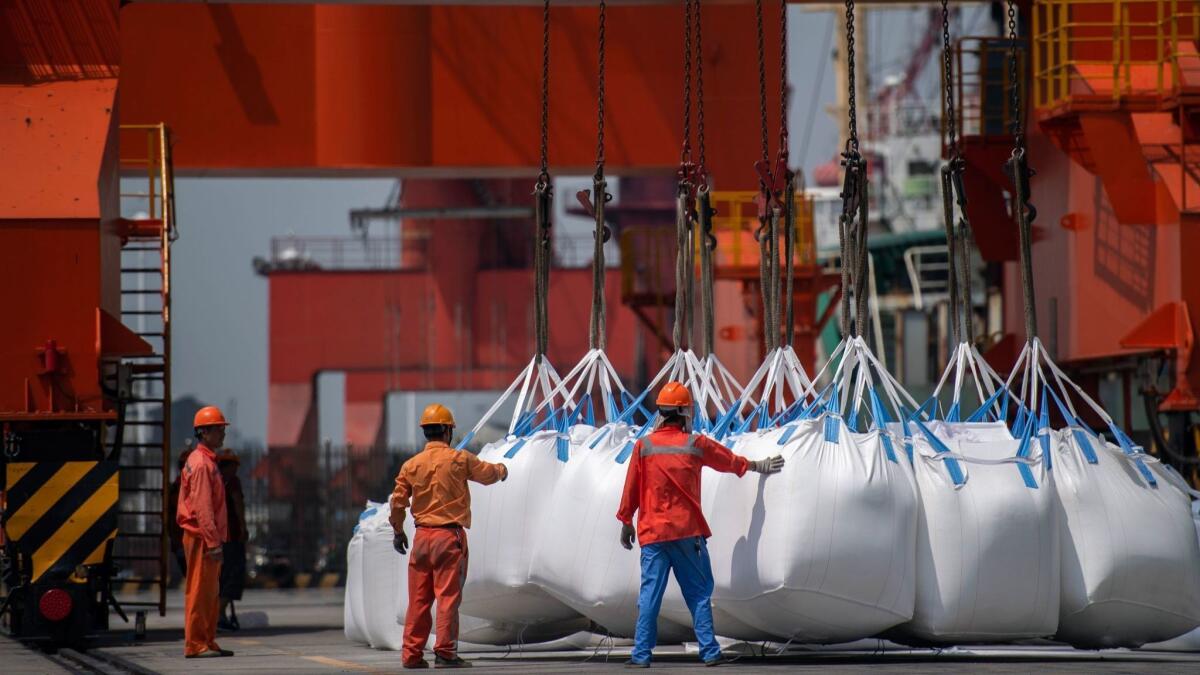UCLA forecasters say the U.S. economy will downshift in 2019 and 2020

- Share via
The United States is “playing with fire” in launching a trade war with China and its economic growth will plummet over the next two years as the stimulus of tax cuts and spending increases wanes and interest rates rise, according to a new forecast from the UCLA Anderson School of Management.
“The economy is in the process of downshifting from the 3% growth in real GDP this year to 2% in 2019 and 1% in 2020,” warned senior economist David Shulman, author of the group’s national forecast.
And President Trump’s repeated predictions that the economy will grow at 4% to 6%?
“It’s not going to happen,” Shulman said. “We think it is going to slow a lot more than what the president’s people are saying.
“Typically administrations — whether they’re Republican or Democratic — are more optimistic than other forecasters. But the Trump administration has exaggerated more than other administrations.”
Along with a shrinking gross domestic product, job growth is likely to sink from the 190,000 average monthly gain this year to 160,000 a month next year, and a far weaker 40,000 a month in 2020, according to the UCLA outlook.
Unemployment is predicted to decline to 3.5% for most of 2019, from the current 3.7%, then gradually grow to 4% by the end of 2020.
UCLA’s quarterly report, one of the most widely watched economic outlooks for California and the nation, will be presented Wednesday at a campus conference featuring financial experts from industry and academia.
The forecast, while more bearish than some, Shulman noted, roughly correlates with other private economists’ assessments. “Growth is likely to slow significantly next year,” Goldman Sachs said in its 2019 outlook, issued last month. “We expect tighter financial conditions and a fading fiscal stimulus to be the key drivers of the deceleration.”
J.P. Morgan’s economic update this month warned of several risks. “Trade tensions may result in a slowdown in global growth,” it said. “The Federal Reserve may tighten monetary policy too aggressively. Weak labor force growth could hinder economic growth in the future.”
The forecast’s California section, drafted by economists Jerry Nickelsburg and William Yu, predicts the state’s unemployment rate will rise to an average of 4.5% in 2020, from 4.1% last month. Payroll growth is expected to slow from 2% this year to 1.5% next year and 0.9% in 2020.
“We are at full employment, so we are running out of workers,” Nickelsburg said. “You don’t have a large pool of unemployed people to draw on.”
And the fact that payroll employment is growing faster than the labor force may mean that companies are converting contract workers into payroll employees to retain them, he added.
California’s personal income growth, adjusted for inflation, is forecast to be in the upper 3% range in 2019 and will cool to just below 3% in 2020. Home building will accelerate to about 140,000 units annually by the end of the forecast horizon in 2020, from 125,100 this year.
Shulman, a former managing director at Lehman Bros. and a former Salomon Bros. research director and equity strategist, sees “financial turbulence ahead” for Wall Street.
“The recent volatility in stock prices appears to signal that the era of benign financial markets we have been used to for the past several years is coming to an end,” he wrote.
The most serious risks? “Over-leveraged corporations and escalating trade tensions, especially with China,” he said. “While the zero and low-interest rate policy of the Federal Reserve helped pull the economy out of the Great Recession and later stimulated growth, it induced corporations to leverage up,” or take on debt.
“For example, AT&T borrowed $190 billion to finance its acquisitions of Time Warner and DirecTV. And AT&T was far from alone, with such debt-financed acquisitions made by Bayer, Verizon Communications, Abbott Laboratories, Walgreens Boots Alliance, CVS and Broadcom.”
The debt-financed buying spree “has the potential to trigger the next recession,” Shulman said. “Note that the last three recessions had their origins in the financial markets. The 1990 recession was caused by overzealous lending in commercial real estate and the overbuilding of shopping centers. In 2001, it was too much stock-market exuberance in technology and telecom shares. In 2007, it was the mortgage market. This time the issue is corporate credit.”
Trump can take credit for a booming economy this year, Shulman said, “but we are going to pay for it with deficits of trillions of dollars as far as the eye can see. The stimulus of tax cuts and spending increases was overdone and its effects will wane next year. The whole economy will pay for it with higher debt service on the deficit.”
On the trade front, he added, “Trade wars have a way of escalating. A tariff war means slower growth and higher prices, which is a formula for stagflation. It is not a happy picture, and it can end with inflation and recession.”
Twitter: @margotroosevelt
More to Read
Inside the business of entertainment
The Wide Shot brings you news, analysis and insights on everything from streaming wars to production — and what it all means for the future.
You may occasionally receive promotional content from the Los Angeles Times.











